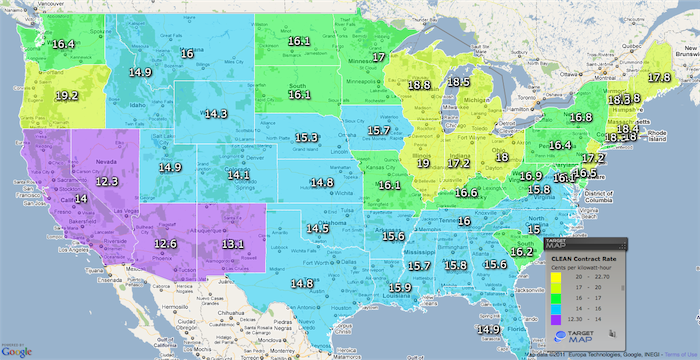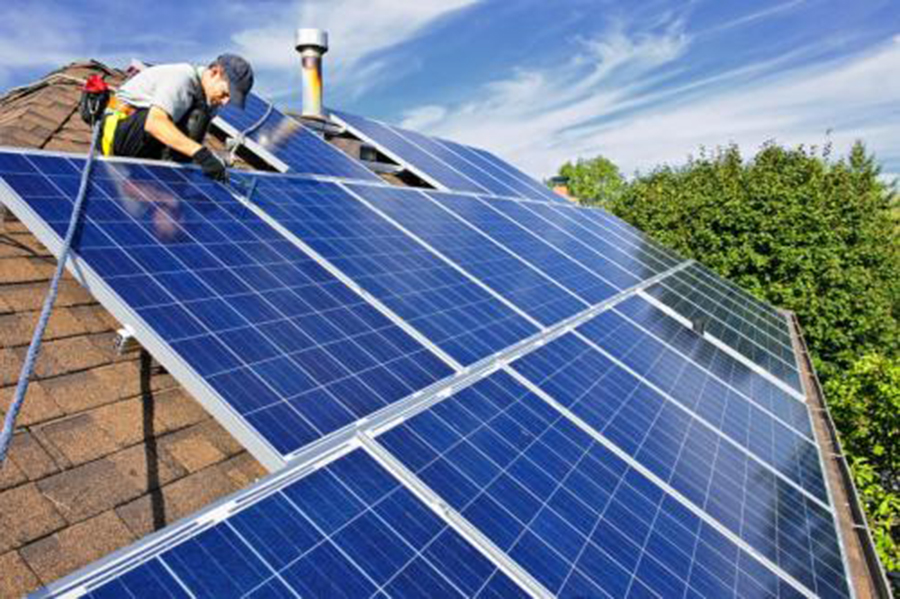The price of solar is dropping fast, opening new opportunities for community-scale renewable energy across the country. But despite the improving economics and tremendously sunnier skies, the United States lags far behind Germany in installing new solar power. What might happen if the U.S. adopted Germany’s flagship “feed-in tariff” policy, responsible for 10 gigawatts of solar in just two years? Let’s take a look at how such a program would be priced.
First, we’re marketing conscious in America, so we’ll call it something better, like a CLEAN contract, for Clean Local Energy Accessible Now.
Then we’ll need to adjust the German prices in three ways:
- Convert euros to dollars
- Adjust for U.S. sunshine
- Adjust for federal tax incentives
But before we dive in to the German solar program, let’s quickly look at the raw cost of producing solar electricity in the U.S. along with the major federal incentive. The following map (click here for an interactive version) illustrates the so-called “levelized cost” of solar PV, the total cost of the system (minus the 30% federal tax credit) divided by its expected electricity production over 25 years, based on an installed cost of $3.50 per Watt (common in Germany, and possible for distributed solar PV in the U.S.):
Levelized Cost of Solar PV @ $3.50/W over 25 years – 30% ITC included
Prices have fallen so much, that they are comparable to or lower than retail electricity rates in selected states in the Southwest (with great sun) or Northeast (with high electricity rates). The following map illustrates (click here for an interactive version):
Average Residential Retail Electricity Rate (Feb. 2011)
So, solar is narrowing the gap with retail grid electricity rates.
Now, back to the analysis of a U.S. CLEAN contract program. We start with the rates the Germans pay for solar PV under their feed-in tariff. The euro to dollar exchange rate is currently around 1 to 1.4, giving us the following starting rates for rooftop solar PV projects in U.S. dollars per kilowatt-hour:
|
< 30 kW |
30-100 kW |
> 100 kW |
> 1000 kW |
|---|---|---|---|
|
$0.405 |
$0.385 |
$0.365 |
$0.304 |
The Germans pay these rates to anyone who can put up a solar panel, per kilowatt-hour sent to the grid, for 20 years. These rates may seem high, but we’re just getting started.
Next, we have to adjust these rates down to account for the significantly better sunshine in the U.S. For illustration, Albany (NY) has 33% better sunshine than Munich (Germany), even though Munich is in the “sunny south” of Germany. Los Angeles gets almost 70% better sunshine than Munich. We’ll pick St. Louis, MO, for its central location and average U.S. solar resource. The following table illustrates the dramatic drop in the price required to offer a modest return on investment for a rooftop solar project.
|
< 30 kW |
30-100 kW |
> 100 kW |
> 1000 kW |
|---|---|---|---|
|
$0.27 |
$0.26 |
$0.25 |
$0.21 |
As good as these values look, we’re still leaving money on the table. Almost every solar PV project built in the U.S. will take advantage of the 30% tax credit (even if they have to let a third party skim off up to half its value). With a full 30% discount, however, the prices for solar PV projects in St. Louis would drop as follows:
|
< 30 kW |
30-100 kW |
> 100 kW |
> 1000 kW |
|---|---|---|---|
|
$0.21 |
$0.20 |
$0.19 |
$0.16 |
The following map provides a look at the prices for a CLEAN contract for rooftop solar PV (< 30 kW) in each state, based on one of the state’s sunnier locations (click here for an interactive version). Prices would be up to 25% lower for the largest PV projects (over 1 MW).
CLEAN Rate for < 30 kW Rooftop Solar PV @ $3.50/W – ITC only
In many cases, commercial developers of PV can claim accelerated depreciation in addition to the federal 30% tax credit. With this additional discount (worth around 20% of the project cost), the cost of a CLEAN contract falls even further, as shown on the map (click here for an interactive version). Once again, prices would be up to 25% lower for PV projects 1 MW and larger.
CLEAN Rate for < 30 kW Rooftop Solar PV @ $3.50/W – ITC and depreciation
There’s a danger to looking at CLEAN contract rates with federal incentives, for two reasons:
1) Many individuals and entities (e.g. schools, cities, nonprofits) can’t effectively use a tax credit incentive.
2) Tax incentive programs expire or are killed by “budget hawks” (or ideologues) in Congress.
The 30% federal investment tax credit for solar is in statute until 2016, but let’s assume for a moment that it expired or that we want to look at the CLEAN contract rates for projects not able to use any federal incentives for solar power. We still assume an installed cost of $3.50 per Watt.
CLEAN Rate for < 30 kW Rooftop Solar PV @ $3.50/W – no incentives (click here for an interactive version):

This chart is a more accurate representation of the state of solar economics (without incentives). It’s also the price required for the most democratic solar incentive program, one that would not be prejudiced against participants who couldn’t effectively use the federal tax incentives.
In the end, a CLEAN program in the U.S. will likely be premised on the use of one or both federal tax incentives and pay much less than this last chart. It will make sense for ratepayers, but will probably not have the same democratizing effect as Germany’s flagship program.



